NOVEMBER 2016 UPDATE – GoPro have now released an updated version of the Session – see our full article on that camera and the new GoPro range here! However, note that the Hero 4 Session discussed in this article is effectively identical to the new Hero Session camera apart from the newer camera having a USB-C port.
GoPro Hero 4 Session vs GoPro Hero+ LCD and GoPro Hero 4 Silver
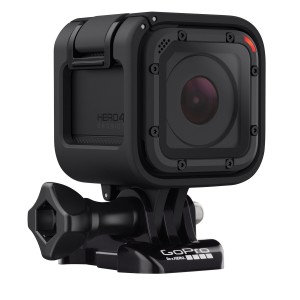 In 2015, for the first time ever in its 10 year history, GoPro introduced a new camera which departed from its established formula of being a rectangular “box” wrapped in a separate waterproof casing. The Hero 4 Session is a 1.5 inch black cube, with a lens on one side, two buttons, and a tiny display. Unlike all the other previous GoPro models (though in common with the new 2016 models!), it is waterproof without a case, albeit only to 33 feet (vs 120 feet for the cased-models). With a weight of only 2.6 ounces (74g), it’s 50% smaller, and 35% lighter than the Hero 4 Silver.
In 2015, for the first time ever in its 10 year history, GoPro introduced a new camera which departed from its established formula of being a rectangular “box” wrapped in a separate waterproof casing. The Hero 4 Session is a 1.5 inch black cube, with a lens on one side, two buttons, and a tiny display. Unlike all the other previous GoPro models (though in common with the new 2016 models!), it is waterproof without a case, albeit only to 33 feet (vs 120 feet for the cased-models). With a weight of only 2.6 ounces (74g), it’s 50% smaller, and 35% lighter than the Hero 4 Silver.
This tiny form factor is clearly a huge selling point for GoPro. As small as their cameras are by comparison to normal ‘compact’ cameras, the regular GoPro cameras can seem a bit chunky when mounted, particularly on a helmet, or when trying to get an innovative shot – the Session’s official promo video is full of shots taken with the camera mounted in all kinds of places you simply couldn’t fit a regular GoPro (such as on the spokes of a mountain bike!).
Interestingly, GoPro had a major rethink about the price point of the Session. When it was launched in the summer of 2015, it cost a cool $400. However, GoPro fairly quickly reduced this to $300, and then in December 2015 slashed it to just $200. We can only assume that this was as a result of poor sales of the Session at its original price, rather than it being a deliberate marketing strategy by GoPro. It does mean that the Session’s obvious rivals within the GoPro range definitely changed after its launch – notably, it was no longer really a competitor for the $400 GoPro Hero 4 Silver. Further down in this article, we’ve done some quick comparisons of the Session against the following 2015 GoPro cameras:
- the bargain entry-level Hero at $129; and
- the Hero+, which now costs the same $200 as the Session and has similar video specs.
(Note that you will probably want to check out our article on the latest iteration of the Session compared to the new Hero5 range of cameras, which you can find here!)
Overview of the GoPro Hero 4 Session
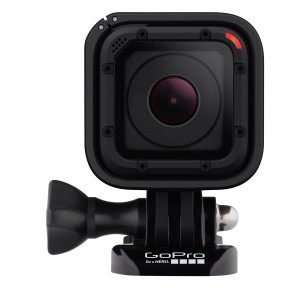 There is no denying that the GoPro Hero 4 Session is a seriously sexy bit of kit. The black cube is genuinely small, and both its colour and size lead to it being much less obtrusive when mounted. The Session fits into a frame mount, which it turn has a standard GoPro mounting connection, so it can be used with all of the existing GoPro mounts. As mentioned above, the Session is waterproof to 33 feet without the need for a case, which should be sufficient for nearly all activities you might envisage using it for, other than scuba diving. That said, the lack of a case is likely to mean that the camera will suffer more from knocks and scrapes than the regular GoPros, and there is no possibility of simply replacing the case if it does suffer damage.
There is no denying that the GoPro Hero 4 Session is a seriously sexy bit of kit. The black cube is genuinely small, and both its colour and size lead to it being much less obtrusive when mounted. The Session fits into a frame mount, which it turn has a standard GoPro mounting connection, so it can be used with all of the existing GoPro mounts. As mentioned above, the Session is waterproof to 33 feet without the need for a case, which should be sufficient for nearly all activities you might envisage using it for, other than scuba diving. That said, the lack of a case is likely to mean that the camera will suffer more from knocks and scrapes than the regular GoPros, and there is no possibility of simply replacing the case if it does suffer damage.
Operating the Hero 4 Session is simple – indeed, perhaps too simple! Effectively, the GoPro powers up and starts recording video with a single push of the button main button on the top; when you stop recording it powers down. The other, much smaller button is to turn the wifi on and off. In order to change the video resolution or tweak any other setting, you have to either use the GoPro smartphone app, or buy an $80 SmartRemote. In some respects it’s a slightly strange decision by GoPro, given that for 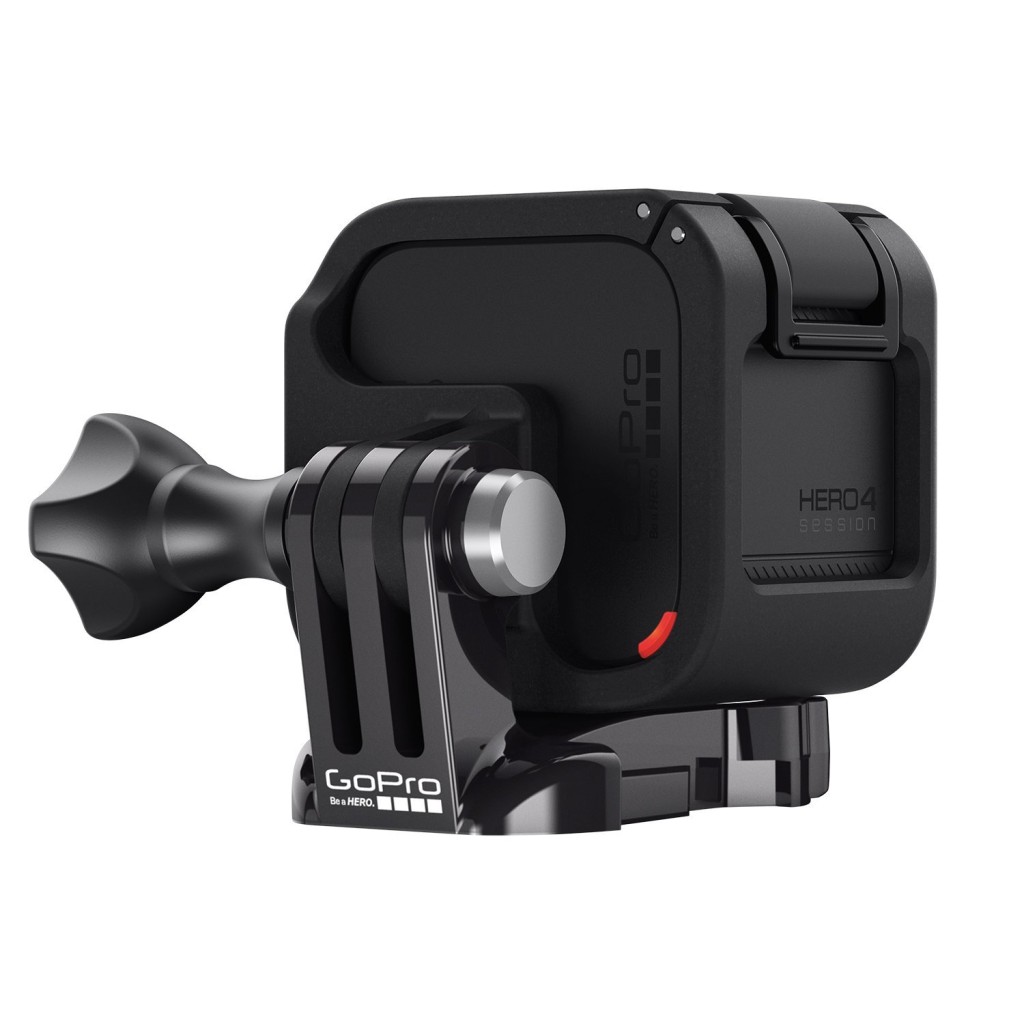 years the original Hero 1 and 2 models used fundamentally the same basic hardware available here (two buttons and a small screen) to allow access to all the camera settings, albeit via a somewhat impenetrable set of codes and symbols! We can understand why GoPro have done it this way though – it’s in keeping with the ethos of the Session as a simple device which you set up once with your desired video settings, and then leave it to get on with the filming. As with the other GoPros, the smartphone app can be used to review footage and frame the shots.
years the original Hero 1 and 2 models used fundamentally the same basic hardware available here (two buttons and a small screen) to allow access to all the camera settings, albeit via a somewhat impenetrable set of codes and symbols! We can understand why GoPro have done it this way though – it’s in keeping with the ethos of the Session as a simple device which you set up once with your desired video settings, and then leave it to get on with the filming. As with the other GoPros, the smartphone app can be used to review footage and frame the shots.
Photo and video resolutions
The Hero 4 Session offers the following main video resolutions:
- 1440p at 30fps (4:3 aspect ratio)
- 1080p at 60fps (16:9 widescreen aspect ratio)
- 720p at 100fps (16:9 widescreen aspect ratio)
 As such, the top video resolutions offered by the session are 1080p60, or 1440p30. This puts it slightly ahead of the GoPro Hero+ and Hero+ LCD models (which don’t offer the 4:3 1440p mode), and well ahead of the much cheaper Hero, but considerably behind the Hero 4 Silver, which boasts 2.7k at 30fps and even 4K (at an admittedly not-that-useful 15fps). As noted above though, the Session now costs only half as much as the Hero 4 Silver, so it is not surprising that it has a lower set of video specs.
As such, the top video resolutions offered by the session are 1080p60, or 1440p30. This puts it slightly ahead of the GoPro Hero+ and Hero+ LCD models (which don’t offer the 4:3 1440p mode), and well ahead of the much cheaper Hero, but considerably behind the Hero 4 Silver, which boasts 2.7k at 30fps and even 4K (at an admittedly not-that-useful 15fps). As noted above though, the Session now costs only half as much as the Hero 4 Silver, so it is not surprising that it has a lower set of video specs.
Stepping down the resolutions, 100fps is available at 720p, making decent slow motion footage (around a 3x reduction in speed) a possibility. It will also shoot in WVGA, but no one should really be choosing that option with a GoPro in 2016!
On the still photograph side, the Session can take 8MP photos at a burst rate of up to 10 shots per second, or be set to shoot in timelapse mode with various intervals, or in single shot mode. As with the video settings though, the shooting mode can only be set via the app or a smart remote.
Battery
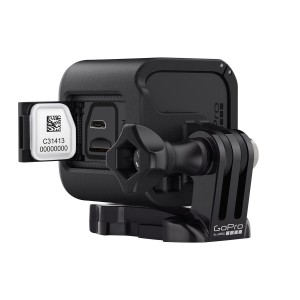 In common with the Hero, Hero+ and Hero+ LCD models, the battery on the Hero 4 Session is built in and non-removable. This is understandable given the size constraints, and the need to make the device waterproof without an external case. However it does mean that, as with the Hero, Hero+ and Hero+ LCD, the camera can only be operated for as long as it will last on a single charge. GoPro say this is in the region of 2 hours, but – as ever – this is likely to vary depending on the ambient temperature and the condition of the battery. This last point highlights a downside of all devices with a built-in battery – the battery performance will inevitably decrease over time, and if you use the Session a lot, you may find yourself in a couple of years with a camera with a significantly degraded battery life, but no way to swap out the battery for a new one. Then again, GoPro may be betting on the fact that by that stage, users will be ready to upgrade to a new and improved model in any event (much like we do with smartphones, which also have the same non-replaceable battery issues).
In common with the Hero, Hero+ and Hero+ LCD models, the battery on the Hero 4 Session is built in and non-removable. This is understandable given the size constraints, and the need to make the device waterproof without an external case. However it does mean that, as with the Hero, Hero+ and Hero+ LCD, the camera can only be operated for as long as it will last on a single charge. GoPro say this is in the region of 2 hours, but – as ever – this is likely to vary depending on the ambient temperature and the condition of the battery. This last point highlights a downside of all devices with a built-in battery – the battery performance will inevitably decrease over time, and if you use the Session a lot, you may find yourself in a couple of years with a camera with a significantly degraded battery life, but no way to swap out the battery for a new one. Then again, GoPro may be betting on the fact that by that stage, users will be ready to upgrade to a new and improved model in any event (much like we do with smartphones, which also have the same non-replaceable battery issues).
A potentially more problematic issue (for some users at least) is the maximum of 2 hours of battery life before you need to plug the Session into a wall outlet. However, as we’ve previously commented in relation to the Hero, Hero+ and Hero+ LCD models, it’s quite likely that many users would never buy a spare battery even if one was available, and are quite happy to make do with the running time from a single charge. And, because the Hero 4 Session shuts down whenever it is not recording, the battery is likely to last longer than that on a standard GoPro where the camera can tend to be left on but not recording between shots.
Buyers’ Guide
So, if you are considering buying a GoPro, should you opt for the Session, or choose one of the other ‘traditional’ GoPros?
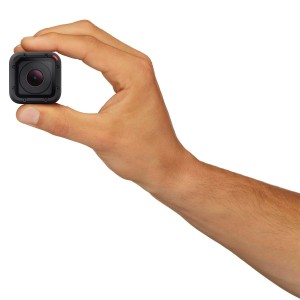 The first point to consider is that if you really love the shape and size of the Session, clearly only this model is going to give you what you want! Seen next to a ‘naked’ (ie without its waterproof housing) regular GoPro, the difference is not quite so apparent, but once you factor in the housing which is necessary for almost all applications of the regular Hero range, it is apparent that the Session really is considerably smaller. However, this small size is perhaps only a genuine advantage in two main circumstances:
The first point to consider is that if you really love the shape and size of the Session, clearly only this model is going to give you what you want! Seen next to a ‘naked’ (ie without its waterproof housing) regular GoPro, the difference is not quite so apparent, but once you factor in the housing which is necessary for almost all applications of the regular Hero range, it is apparent that the Session really is considerably smaller. However, this small size is perhaps only a genuine advantage in two main circumstances:
- Firstly, if you plan to mount the GoPro mainly on your head, or on some other part of your body – here, the lower size and weight of the Session, and its ability to be mounted almost flush with the surface, are a clear step on from the regular GoPro cameras, which can feel a bit clunky (particularly when mounted on top of a helmet).
- Secondly, if you have plans for mounting the GoPro in some particularly innovative ways. The official GoPro Session video has some great shots with the camera clipped (for example) to the end of a kayak paddle, or mounted inside the rim of a wheel on a bike – and there are countless other examples where you could do something clever with the small sized Session which would be difficult with a regular GoPro.
However, if you have other plans for mounting the camera, there may be no particular advantage to the Session over the other GoPro cameras. For example, if you plan to mount the camera on a vehicle, or even a bike, or use it at the beach as a rugged action camera, then the Session is unlikely to be a better camera than the regular GoPros; indeed, as discussed below, the slightly larger cameras may in fact outshine it.
Bearing this key size consideration in mind, here is our assessment of the other pros and cons of the Session against its natural competitors in the GoPro range.
GoPro Hero 4 Session vs GoPro Hero
The key point in the GoPro Hero’s favour here is price. At $129, it’s $70 cheaper than the Session. However, for that $70 you do get a considerable bump in the video specs with the Session – the Hero is only capable of a maximum of 1080p30, so it lacks both the 1080p60 and the 1440p30 modes that the Session gets. For users on a tight budget who just want a GoPro to record some action and aren’t too fussed about mounting it in tricky locations or slowing down the footage, the Hero will likely do just fine. However, in our view the extra video resolution on the Session is worth the increase in the price.
GoPro Hero 4 Session vs GoPro Hero+
This is a really interesting comparison, given that the two cameras are now identical in price at $200 – thought when the Session was first launched, it was double the price of the Hero+. Both cameras have effectively the same video specs – while the Session has a technically higher top resolution of 1440p30, this is a 4:3 aspect ratio setting (i.e. more “square” than the standard widescreen 16:9 ratio, and therefore probably less useful to most users). At the widescreen 1080p setting, both cameras shoot a maximum of 60 fps. Both can also take 8MP still photos, though the Session has a higher burst rate of 10 fps vs 5 fps for the Hero+. Both also have non-removable batteries. As such, now that the price of the Session has been reduced, the choice between the cameras comes down to matters of their usability and physical characteristics:
The key factors in favour of the GoPro Hero 4 Session are as follows:
- Size and weight – 50% smaller than the Hero and 33% lighter
- Potentially better battery life (depending on how it is used)
- Better mounting options, including flush mounting
While the key factors in favour of the GoPro Hero+ are as follows:
- Better waterproofing – down to 133 feet vs only 33 feet on the Session
- Likely to be more rugged in general given the lack of an external case on the Session
- All settings can be operated from the camera alone, without the need to use the phone app or a remote
Obviously how you plan to use the camera will influence your decision here. For our $200, we prefer the Hero 4 Session over the Hero+. Unless you really need the extra waterproof rating (which only really applies if you plan on scuba diving with the camera), then the Session is a smaller, better looking and more versatile camera. The fact you can’t change the settings without using the app isn’t really a problem in practice, since you tend to chose the setup that works for you before you start shooting, and then leave it alone for the rest of the time.
Conclusions
It was hard not to be a little disappointed when the GoPro Hero 4 Session was launched – while it was exciting to see a GoPro that finally stepped outside of the “classic GoPro” shape, it was difficult to justify spending $400 on a camera that effectively maxed out at 1080p, when for the same money you could buy a GoPro Hero 4 Silver which could shoot in 4K and featured a built-in LCD touchscreen. However, since the price was slashed by 50%, the Session has become a much more interesting possibility. Yes, it still has limitations – notably the lack of a replaceable battery – but crucially it shares those limitations with the other standard GoPros at around this price point – the Hero and Hero+. While there might be some specific reasons why one of those cameras might be better for you than the Session, for the majority of people we now reckon the Session is the best way to spend $200 on a GoPro, and we expect to see many more Sessions out there during 2016!
We hope you’ve found this article useful! If you’re ready to buy a GoPro (or anything else for that matter) and click on one of the Amazon links above (or here) then this website earns a small commission on any purchase you make – though it doesn’t cost you any more! And do let us know if you have any questions or comments below. Thanks!
